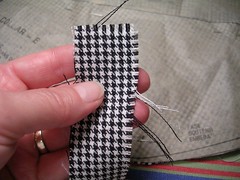
It does fray quite a bit so I had to be a little careful handling the pieces once I cut them, so it didn't fray down into where the seams would end up. I also ended up with way more than I needed for a skirt, even if I did plan to use the 8 gore pattern I'd used before (McCall's 3518). I laid out the skirt pattern pieces and then sized up what was left, to see what else I might get out of the fabric.
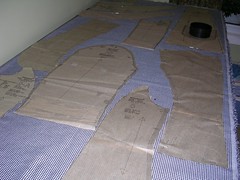
There wasn't enough for a full-fledged jacket but I didn't think the fabric was right for something like a shirt. That's when I remembered the little unlined jacket pattern I had made before (Simplicity 4698).

If I went with the 3/4 sleeves, I might just have room for all the pieces. As it turned out, I didn't quite, but that's the next story. First, I wanted to get the skirt made so I could start wearing it, even if the (Canadian) Thanksgiving weekend (October 7-9) was delightfully sunny and in the 20s.
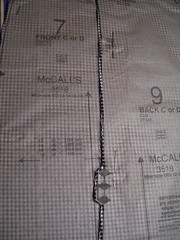
My biggest problem with this 8 gore skirt pattern is keeping all 8 pieces organized, especially as in this case, when the fabric is identical on the right and wrong sides. I carefully unpinned the pattern pieces from the gores that go in the centre of the front and the back and then I pinned the pieces together so I wouldn't mix them up.
I also had decided this time that I would finish the seams as French seams and not use the flat fell. I thought it would be better for this fabric if I didn't have lines of stitching running down the right side all over the place. With a French seam (or at least my version of it), you first pin the pieces together with the WRONG sides together. Then you sew about a 1/4 inch seam, trim it, iron it and then fold the two pieces now with their RIGHT sides together and sew another 1/4 inch seam. thus enclosing the raw edge completely.
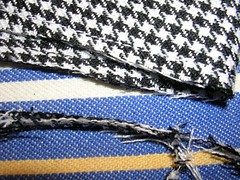
Here is one seam, with the first line of stitching completed and the raw edge trimmed. You can also see here that I used white thread on the top and black thread on the bobbin, just to try to blend the thread in with the contrasty fabric.
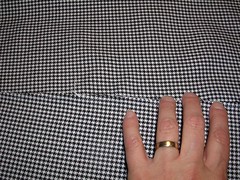
Once you have stitched the seam once, trimmed the raw edge (but not too closely because it will continue to fray), and ironed it flat, then you have to prepare for sewing the second line of stitching. Before you fold the pieces together, right sides together, along the first stitching line, you need to make sure the threads from the raw edge (which are unravelling already even though you just trimmed them) don't poke through the stitching line (less work trimming them later). I found that I could just smooth the fraying threads along with my hands and then fold the fabric over. On this photo, I am moving my hands from the right side to the left side of the picture, tucking in those loose threads.
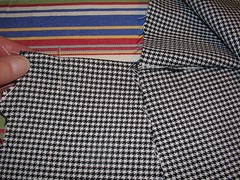
Once I had the fabric folded right sides together, I ironed along the fold and stuck a few pins in to make sure the fabric wouldn't shift as I sewed. This photo shows the pieces already stitched together once and pinned together for the second pass, and I am showing what it looks like inside the fold, with the raw edges of the fabric pieces.
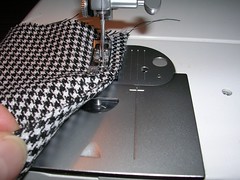
Now I am sewing the second line of stitching which will encase the raw edges and give a finished look to the inside of the skirt. It will also prevent the seams from coming unravelled which would happen after a few wearings. You could serge the seams of course, if you had a serger which I don't.
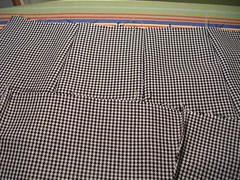
Here is what the panels look like sewn together. The right side (or outside) of the skirt is at the top and I have turned up the bottom of the skirt to show the finished, French seams on the wrong side of the skirt.
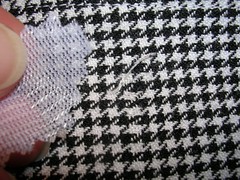
I missed a small flaw in the fabric when I was cutting out the pieces and only saw it when I had put the gores together. A couple of threads in the weave had broken but you couldn't really see this on the outside of the skirt.
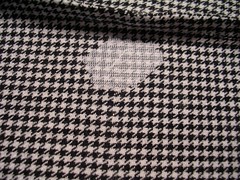
I decided to use a small piece of iron-on interfacing over the flaw on the inside of the skirt. It will seal the loose threads in place and prevent further damage.
7 comments:
That's some nice looking, but challenging fabric. That would make a very pretty skirt. Too funny about Thanksgiving being sunny, but in the 20s. We don't have that kind of temperature here until January. Can't wait to see the finished product!
Hoo, too funny ML. I do mean 20 Celsius of course. :) That's about 68F. Warm enough for a bike ride in shorts! In January we get from your 20F (-6C) to about -22F (-30C). Brr!
As for the skirt, it's done already but I'm just getting around to blogging about it now. Next, a computer case for hubby and then on with the "jacket" thingy. I think I will have to do flat fells for that.
Very good seam idea! I can't wait to see the rest. I'm getting ready to make a jacket myself from fabric that looks like it might fray, and your treatment of the seams may be just the ticket!
Oh, that makes sense then. Tee hee...I forget about the Celsius thing. Very funny!
Hi Cat, welcome to my blog. Stay tuned for flat fells next, in terms of seam finishing. If my fabric is VERY prone to fray, I will even run around each cut piece once with a straight stitch, before I put them together or handle the pieces much. And if it frays a lot, don't clip the seam allowances, otherwise the seams themselves will fail.
ML, I thought you had forgotten about the F and C temperature differences!
Another great tutorial. I've always found french seams adversely affect draping, but perhaps I did it on the wrong type of garment or with the wrong fabric. Did you find it affected the flow of the skirt? I'm looking forward to seeing the finished product.
Hi Miriam, have a look at my next post, about the seams. One day, I'll actually get a photo of me wearing the thing!
Post a Comment